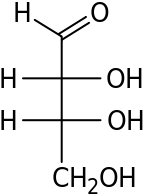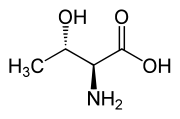Diastereomer
Diastereomers (sometimes called diastereoisomers) are a type of a stereoisomer.[1] Diasteoreomers are defined as non-mirror image non-identical stereoisomers. Hence, they occur when two or more stereoisomers of a compound have different configurations at one or more (but not all) of the equivalent (related) stereocenters and are not mirror images of each other.[2] When two diastereoisomers differ from each other at only one stereocenter they are epimers. Each stereocenter gives rise to two different configurations and thus typically increases the number of stereoisomers by a factor of two.
| Diastereomers that are also epimers | |
|---|---|
 |
 |
 |
 |
| D-Threose | D-Erythrose |
Diastereomers differ from enantiomers in that the latter are pairs of stereoisomers that differ in all stereocenters and are therefore mirror images of one another.[3] Enantiomers of a compound with more than one stereocenter are also diastereomers of the other stereoisomers of that compound that are not their mirror image (that is, excluding the opposing enantiomer). Diastereomers have different physical properties (unlike most aspects of enantiomers) and often different chemical reactivity.
Diastereomerism can also occur at a double bond, where the cis vs trans relative positions of substituents give two non-superposable isomers. Many conformational isomers are diastereomers as well.
Diastereoselectivity is the preference for the formation of one or more than one diastereomer over the other in an organic reaction.
Syn / anti
When the single bond between the two centres is free to rotate, cis/trans descriptors become invalid. Two widely accepted prefixes used to distinguish diastereomers on sp³-hybridised bonds in an open-chain molecule are syn and anti. Masamune proposed the descriptors which work even if the groups are not on adjacent carbons. It also works regardless of CIP priorities. Syn describes groups on the same face while anti describes groups on opposite faces. The concept applies only to the Zigzag projection. The descriptors only describe relative stereochemistry rather than absolute stereochemistry. all isomers are same.
Erythro / threo
Two older prefixes still commonly used to distinguish diastereomers are threo and erythro. In the case of saccharides, when drawn in the Fischer projection the erythro isomer has two identical substituents on the same side and the threo isomer has them on opposite sides.[4] When drawn as a zig-zag chain, the erythro isomer has two identical substituents on different sides of the plane (anti). The names are derived from the diastereomeric aldoses erythrose (a syrup) and threose (melting point 126 °C). These prefixes are not recommended for use outside of the realm of saccharides because their definitions can lead to conflicting interpretations.[5]
Another threo compound is threonine, one of the essential amino acids. The erythro diastereomer is called allothreonine.
  |
| L-Threonine (2S,3R) and D-Threonine (2R,3S) |
  |
| L-Allothreonine (2S,3S) and D-Allothreonine (2R,3R) |
Multiple stereocenters
If a molecule contains two asymmetric centers, there are up to four possible configurations, and they cannot all be non-superposable mirror images of each other. The possibilities for different isomers continue to multiply as more stereocenters are added to a molecule. In general, the number of stereoisomers of a molecule can be determined by calculating 2n, where n = the number of chiral centers in the molecule. This holds true except in cases where the molecule has meso forms—some configurations are equivalent to each other.
For n = 3, there are eight stereoisomers. Among them, there are four pairs of enantiomers: R,R,R and S,S,S; R,R,S and S,S,R; R,S,S and S,R,R; and R,S,R and S,R,S. There are many more pairs of diastereomers, because each of these configurations is a diastereomer with respect to every other configuration excluding its own enantiomer (for example, R,R,R is a diastereomer of R,R,S; R,S,R; and R,S,S). For n = 4, there are sixteen stereoisomers, or eight pairs of enantiomers. The four aldopentoses and the eight aldohexoses (subsets of the five- and six-carbon sugars) are examples of sets of compounds that differ in this way.
Applications
As stated previously, two diastereomers will not have identical chemical properties. This knowledge is harnessed in chiral synthesis to separate a mixture of enantiomers. This is the principle behind chiral resolution. After preparing the diastereomers, they are separated by chromatography or recrystallization. Note also the example of the stereochemistry of ketonization of enols and enolates.
See also
- Cahn–Ingold–Prelog priority rules for nomenclature.
References
- IUPAC "Gold Book" diastereoisomerism doi:10.1351/goldbook.D01679
- Garrett, R.H.; Grisham, C.M. (2005), Biochemistry 3rd ed., Belmont CA: Thomson, p. 205, ISBN 0-534-41020-0.
- IUPAC "Gold Book" enantiomer doi:10.1351/goldbook.E02069
- Modern physical organic chemistry Eric V. Anslyn,Dennis A. Dougherty 2006
- IUPAC, Compendium of Chemical Terminology, 2nd ed. (the "Gold Book") (1997). Online corrected version: (2006–) "erythro, threo". doi:10.1351/goldbook.E02212